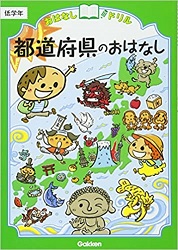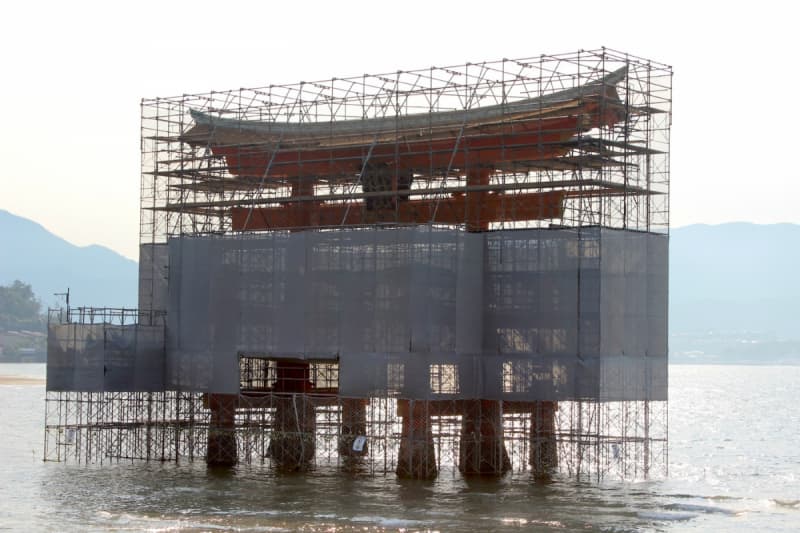Hiroshima prefecture
安芸の宮島
Aki’s Miyajima
JR宮島口駅前にあるさんばしかフェリーにのり十分ほどすすめと、厳島にとうちゃくします。
If you take a ferry from JR Miyajimaguchi Station for 10 minutes, you’ll reach Itsukushima.
海の上にぞびえ立つ大きな赤い鳥居が、厳島のシンボルです。
The big red gate towering over the sea is the symbol of Itsukushima.
厳島は、「安芸の宮島」ともよばれます。
Itsukushima is also often called Aki’s Miyajima.
安芸というのは、このあたりのむかしの地名、宮島というのは、お宮(厳島神社)のあるしまといういみです。
Aki is the name of this region in the olden times and Miyajima is the island where this Shrine (Itsukushima Shrine) is on.
安芸の宮島はむかしから、しまそのものが、しんせいな場所と考えられてきました。
Aki’s Miyajima has been thought of as a sacred place since the olden times.
また、けしきのうつくしいことで有名です。
Also, it’s famous for its beautiful scenery.
Yamaguchi prefecture
秋吉台と、秋芳洞
Akiyoshidai and Akiyoshidou
山口県の秋吉台は、広大なカルスト台地です。カルスト台地とはいったい何でしょうか。
Yamaguchi Prefecture’s Akiyoshidai is a vast karst plateau. What exactly is a karst plateau?
石灰岩がたくさんふくまれている土地が、長い年月のうちに、雨水にとけてでき上がったのがカルスト台地です。
Karst plateau is an area with lots of limestone shaped by rainwater dissolving it over a long period of time.
カルスト台地では、とけのこった石灰岩のかたまりが、草原からたくさん顔を出しています。
In Karst Plateau, the lumps remaining from limestone dissolution can be seen from the meadows.
これはまるで、ひつじのむれのように見えます。
These stones are round resembling a flock of sheep.
カルスト台地の地下には、どうくつができます。
Cave formed underneath the karst plateau.
秋吉台の下のどうくつは、秋芳洞とよばれています。
The cave underneath Akiyoshidai is called Akiyoshidou.
しぜんの力によってできた、ふしぎな地形です。
A strange land formation created by the power of nature.
Tokushima prefecture
あわおどりって、なに?
What is Awa dance festival?
「手を上げて、足をはこべば、あわおどり」といわれるように、あわおどりは、大人もこどもも楽しめるおどりです。
As the saying goes “If you raise your hand and bring(?) your feet, it’s Awa dance”, it’s a dance that can be enjoyed by both adults and kids.
あわおどりは、両手を上げたしせいで、右手と右足、左手と左足をそれぞれ同時に、こうごに前につき出しながらおどります。
Awa dance is a dance performed by raising both limbs, right hand with right feet, left hand with left feet, bringing them to the front at the same time.
三味線、たいこ、ふえなどの音楽が、二びょうしでかなでられます。
Shamisen, taiko drum, and bamboo flute music ???
四百年いじょうのれきしをもつ徳島県のあわおどりは、毎年八月にひらかれます。
Tokushima Prefecture’s Awa dance carries a history of over 400 years and is performed every year in August.
日本全国から、のべ百万人いじょうものかんこうきゃくがあつまります。
From all over Japan, it gathers a total of more than 1 million visitors.
Kagawa prefecture
おいしい、さぬきうどん
Delicious sanuki udon
太めでこしがある、さぬきうどん。みなさんは、すきですか。
Thick and chewy sanuki udon. Do you like it?
さぬきうどんは、香川県の名物です。
Sanuki udon is Kagawa Prefecture’s specialty
香川ではむかし、うどんのざいりょうになる、小麦のさいばいがさんでした。
A long time ago in Kagawa Prefecture, buckwheat, an ingredient for udon, cultivation thrived.
また、うみにめんしているので、しおや、だしをとるためのいりこの原料となる魚もとれます。
Since it’s overlooking the sea, salt and anchovy needed for the broth can be harvested.
新せんな、よいざいりょうをつかうので、おいしいうどんができるのです。
Fresh and good ingredients makes for delicious udon.
うどんやさんもたくさんできて、あじをきょうそうするうちに、さぬきうどんはますますおいしくなりました。
Many udon shops opened and while competing to be the best tasting, sanuki udon became more delicious.
Questions
- こしがある: my teacher said that this kinda means that the udon is not too soft. I translated it to chewy but not sure if that’s correct.
- 二びょうしでかなでられます: I really can’t guess the meaning of this whole sentence. DeepL translation yields “can be written in two strokes”. Does this have to do with the repetitive music?










